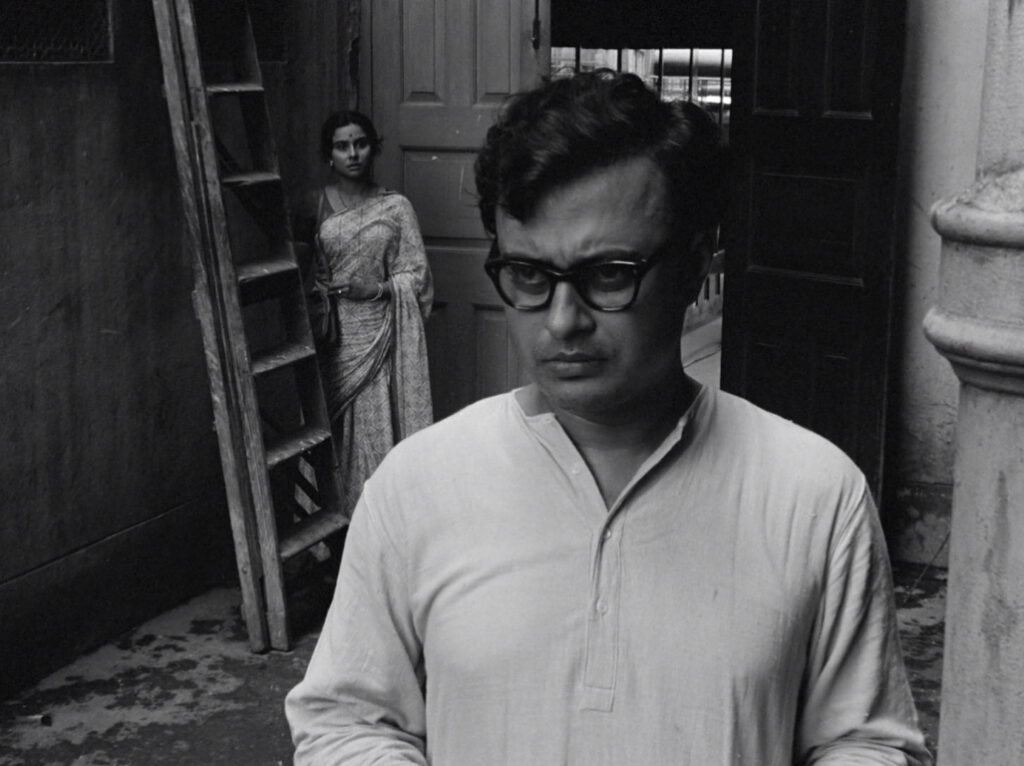
The Big City
1963, directed by Satyajit Ray
One of the quirks of England is that railroad travelers often speak of going “up to London” no matter where they’re coming from. Even from the Scottish Highlands, uphill and to the north, London is “up”. We don’t need a primer in British culture to guess that this expression derives from people looking up to the big city, the way they do all over the world. The same goes for India, whose metropolises drew most of their population from rural and small-town migrants seeking to move up in the world. In Satyajit Ray’s The Big City, Subrata and Mr. Mukherjee bond over their shared origin in a rural district of Bengal. In fact the whole story is about people trying to rise in society and improve their economic positions.
If we view The Big City the conventional way, it’s a touching drama of a lower middle-class family struggling to make their lives better. Audiences can easily find themselves in these characters, but if we take ourselves out of it and let the movie’s insistent patterns speak to our eyes, it’s possible to see it as something else entirely. We can abstract the film, almost to the level of a Hans Richter experimental film from the 1920s, and view it as a long series of variations on the directions “up” and “down”, exploring both movement and relative position on a vertical axis. Once we’ve done this, we can return the humanity to the story and see it as something more than a sentimental family drama.
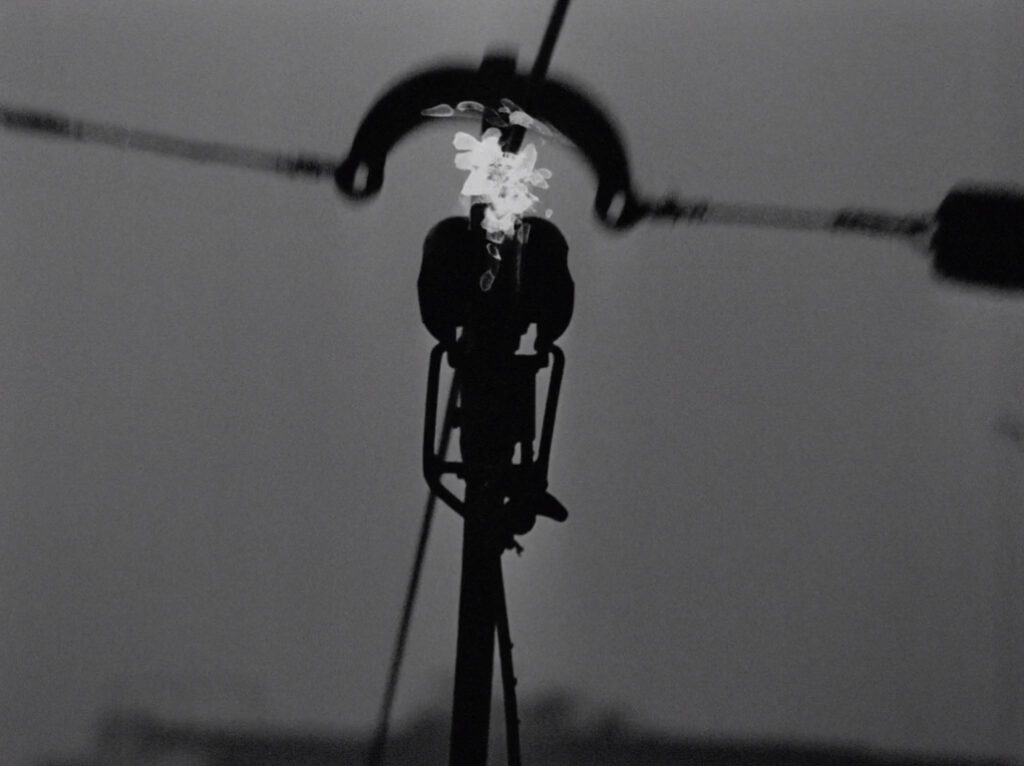
Throughout the opening titles the camera faces the sky, riding atop a tram as the trolley pole collects power from the overhead wire. The camera remains pointed up through the next shot, viewing Subrata from below against the tram ceiling as he rides home. When he steps off we look up at a kite, and even when the camera comes down to his level, the pictured content maintains the idea of upward position or motion: children watching from roofs, Subrata towering over a crowd of children, a balloon vendor, a child tossing a basketball in the air.
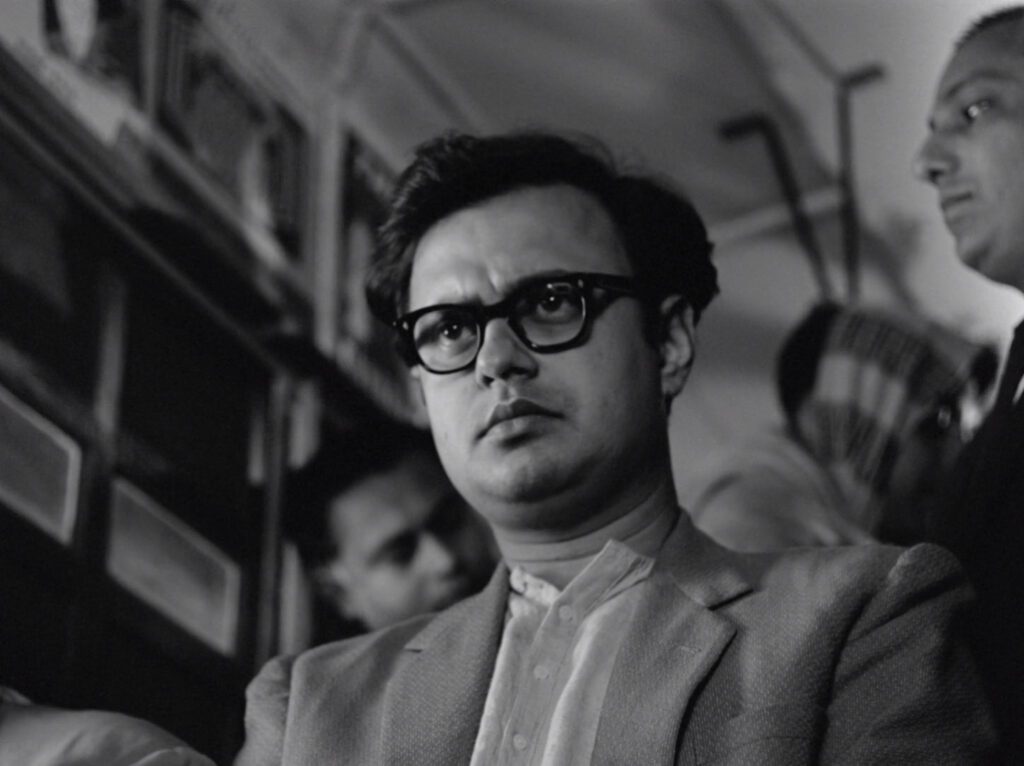
The opening doesn’t so much introduce Subrata as point our vision upward. Once we’ve been alerted to the pattern, the movie does not need to be so literal about it anymore. As soon as Subrata arrives home we find each member of his family figuratively looking up to a possible better life, and the story is centered around their respective efforts to lift themselves up. Subrata’s sister Bani is enrolled in school; his wife Arati decides to get a job; the couple’s little son Pintu is growing up; Subrata’s father tries to become more independent, either by winning a prize or by collecting debts of honor from his long-ago students; and Subrata himself tries to get a second job.
Nevertheless, as if to keep the metaphor alive, the film keeps returning to physical examples of things rising or in lofty positions. To get to her office, Arati must climb a stairway then ride an elevator. Pintu blows soap bubbles in the apartment. Both Pintu and Arati’s co-worker Edith catch fevers, and we hear of their rising temperatures. Subrata’s mother must rise from her cooking spot on the floor to save her sore back. When Arati asks Subrata what questions she’ll get in her job interview, he jokes that they’ll ask “Where does the tree spirit live?” to which she should answer, “In the treetops.” Arati’s boss Mr. Mukherjee recognizes Subrata from a photo taken in front of a giraffe, which may remind us of the opening scene when Subrata had walked like a giraffe among the throng of children.
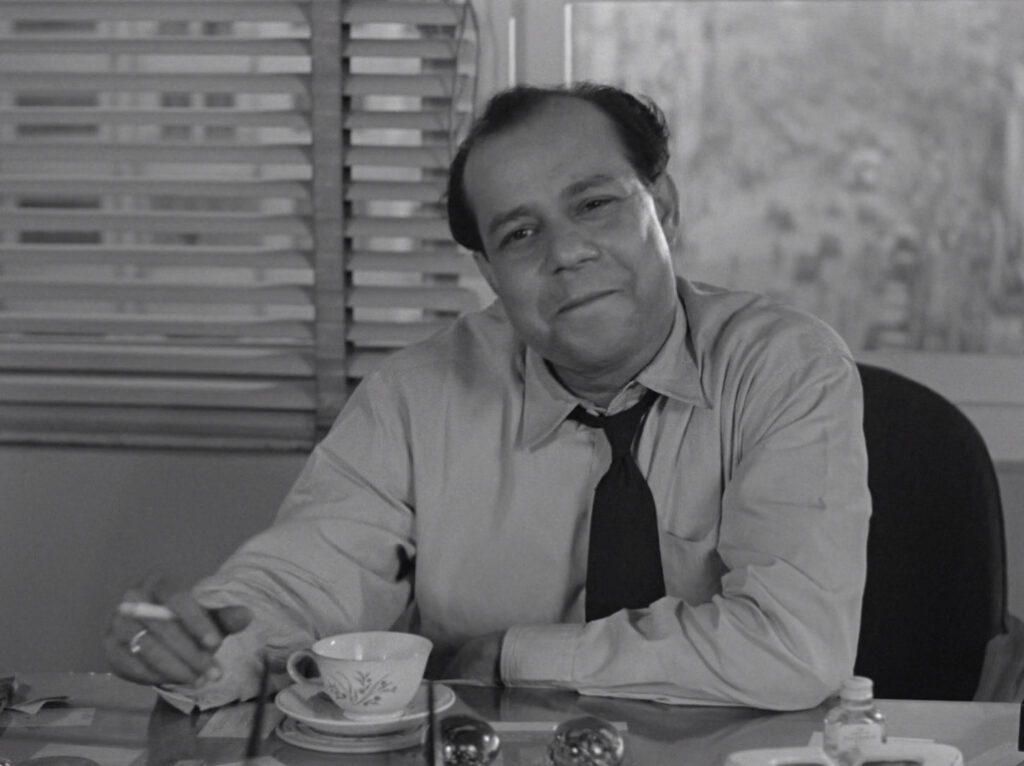
This pattern is slightly complicated by the mention of crossword puzzles, which combine both vertical and horizontal directionality. Subrata’s father is obsessed with the hope of winning thousands of rupees in a crossword contest. Although the puzzle itself can be a metaphor for a society filled with intersecting relationships of both parity and inequality, the operative element here is the contest – the man hopes to come out on top.
With barely a dozen defined characters, The Big City nevertheless manages to include most of the basic human relationships in which one side looks up to the other. A wife looks up to her husband; children look up to their parents; employees look up to their boss; pupils look up to their teacher; colonized subjects look up to their rulers; clients look up to professionals; and the poor look up to the rich. Each of these, however, is also reversed in The Big City. Arati becomes the family’s breadwinner, and Subrata must look up to her. The elderly parents depend on their son and his wife. Edith has contempt for her employer, and Arati stands up to him at the end. Subrata’s father, a retired teacher, finds that his students have far exceeded his modest success. Mr. Mukherjee looks down on the British legacy in India, especially Anglo-Indians like Edith. Subrata’s clients, who had sought his expertise at the bank, turn against him, and Arati’s co-workers gossip disparagingly about the wealthy families they sell knitting machines to.
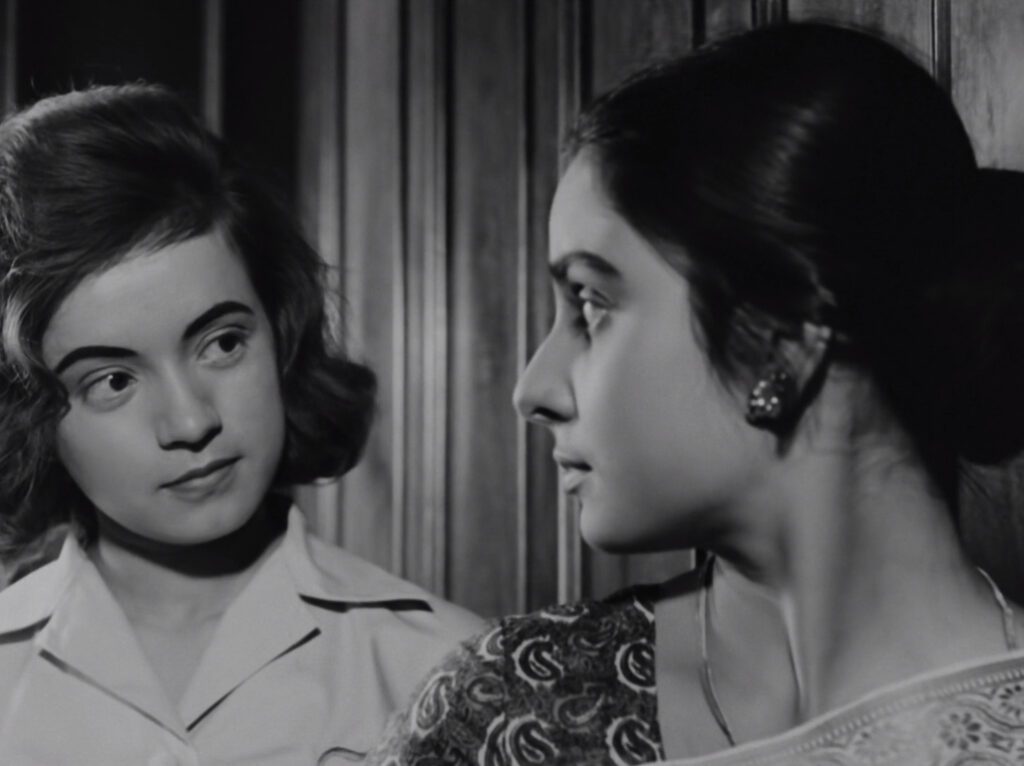
The Big City invests most of its time showing processes of rising, but there are moments of falling as well. To rise requires struggle, whereas falling occurs in a flash. Subrata loses his job in a sudden bank run. His father’s efforts to collect gratitude from his students end abruptly when he collapses atop a staircase, visualized by his cane tumbling toward the ground floor. When Arati quits her job at the end she runs down the stairs, her whirlpool descent illustrated by rapid camera movement and quick editing. As Subrata tells Arati, “Finding a job is hard, but quitting one is easy.” The movie keeps us fully aware of how precarious success is.
For all of the family’s difficulties, however, The Big City does not end with despair. Like so many of Ray’s films, it’s an argument against an inherited point of view that handicaps people’s lives. Pather Panchali shows how separating spirit from matter drains the joy out of life; The Music Room critiques the conservative mindset that prevents adaptation to a changing world; Devi criticizes the impulse to worship other human beings, which keeps people complacent in the face of injustice; and Charulata shows how a romantic worldview damages intimate relationships. With its relentless emphasis on ascending and descending, The Big City asks us to question the dominant role of competition and inequality in modern society, a dominance that comes from a flaw in perspective.
As if to keep reminding us that it’s about perspective, the movie puts special emphasis on eyeglasses. Subrata wears heavy-framed spectacles that stand out on his face. There’s a whole side plot about his father’s desperate quest for new glasses – it’s the family’s most pressing need when Arati decides to seek employment, and it drives the old man to begin visiting his students for help. The first student is an eye doctor who generously gives him new glasses, but on his last outing he falls and breaks them. When Bani catches her sister-in-law looking at want ads, she fantasizes about Arati becoming a movie star with glamorous sunglasses, and later Edith gives Arati a stylish pair of shades.
All these patterns and devices – all the images, actions, and words that point to elevation, falling, and point of view – accumulate subtly yet relentlessly, making The Big City like a fleshed-out equivalent to an abstract animated film of shapes rising and falling. Whether we view it in this detached way or whether we feel involved in its lifelike emotional drama, the movie saves its extraordinary payoff for the last five minutes when everything comes together to reveal its purpose. Arati, having just forfeited her job, runs down the stairs and meets her husband by the doorway. Scared and ashamed, she stands by a ladder as if seeking refuge in the thought of climbing up again. But then Subrata tells her, “I’m by your side.” Finally the pattern is broken, and the two of them are on the same level. One last time she looks up and sees the office building’s vertiginous light well. She thinks again of lifting herself up: “Such a big city. So many different jobs. Surely one of us can find a job.” Again his answer brings them both to the same level: “Let’s try. I’m sure we both will.” There is no longer any thought of competition between them. They are partners, and they clasp hands in solidarity. In the final shot they walk into the street together, side by side, and mingle with the crowd. At first the camera looks down on them from an elevated position, but then it shifts to look straight ahead.
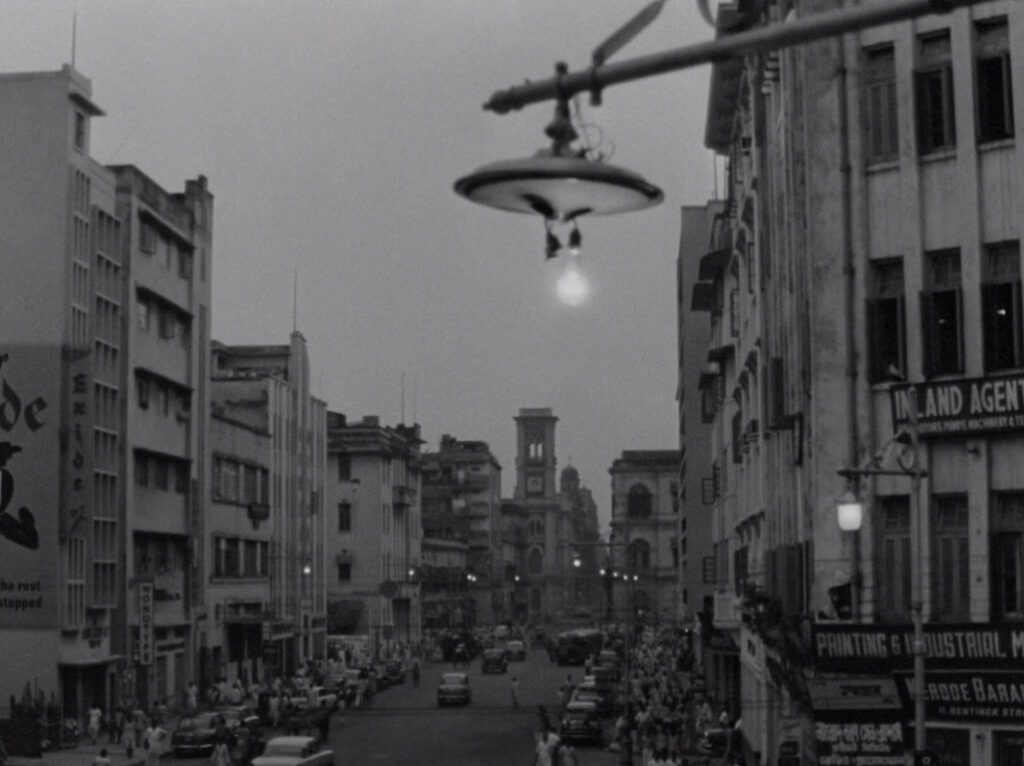
The visual language of these last shots, together with the crowd of ordinary people on the busy street, suggests the possibility of a world where people can join as equals, where everyone can find opportunity. The couple’s clasped hands, their dialogue, and the final shot looking straight ahead contrast with the visual language of the opening, which suggested a world of inequality, even if people might hope to rise within it. There’s also a telling contrast between two kinds of light. The tram at the beginning draws power from an electric wire that gives off sparks. One of these sparks ignites the first music, as if giving life to the moving picture. The final shot zooms in on an electric bulb hanging over the street. Unlike the intermittent jolts of electricity that sustained the competitive world in the opening scene, this new view of life is sustained by a light that’s warm and steady.
CONNECTIONS:
Brief Encounter – Crossword puzzle as a metaphor
The Cloud-Capped Star – Rising and descending motion on stairs as a metaphor for a Kolkata family’s economic mobility
2001: A Space Odyssey – Opening shot defines an ideological point of view (aspirational upward view, privileged view of a syzygy)
The Boss of It All – Critique of the ideology behind modern office life
Parasite – High and low positioning as a metaphor for social mobility or immobility